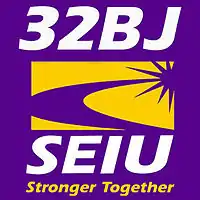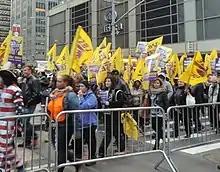SEIU 32BJ
Service Employees International Union, Local 32BJ (often shortened, for example, to SEIU Local 32BJ or 32BJ), is a branch of Service Employees International Union headquartered in New York City representing over 175,000 members in ten northeastern states, Washington, D.C., Florida and other parts of the United States.[2] The largest property service workers labor union in the United States,[3] 32BJ members include office cleaners, security officers, doormen, porters, maintenance workers, engineers, bus drivers and aides, window cleaners, school cleaners, and food service workers.
 | |
| Full name | Service Employees International Union, Local 32BJ |
|---|---|
| Founded | 1977 as SEIU Local 32B-32J |
| Predecessor | #Merged unions |
| Members | 148,201 (2016)[1] |
| Affiliation | Service Employees International Union |
| Key people | Kyle Bragg, President |
| Office location | New York, NY |
| Country | United States |
| Website | seiu32bj |
Composition
According to SEIU 32BJ's Department of Labor records since 2005, when membership classifications were first reported, around a quarter of the union's membership are considered part time.[4]
History
Early Organizing

Between 1902 and 1920, attempts were made to form janitor’s unions, but disadvantages were overwhelming. The American Federation of Labor (AFL) chartered a few early janitor locals but remained chiefly concerned with more skilled trades.
In 1921, seven small local unions led by William F. Quesse of the Chicago Flat Janitors received an AFL charter as the Building Service Employees International Union. By 1928 BSEIU membership had grown to 7,000 members across 50 small locals, with most of the strength still centered in Chicago.
The Great Depression caused many BSEIU locals to fall by the wayside, and the situation in New York City was especially hard. Local 32, Superintendents and Janitors, suffered a wage cut. Locals 58 and 51 were dwindling in members, and Local 14, Harlem Superintendents, had folded. New York janitors and others were working under conditions the Chicago Flat Janitors had won 20 years earlier.
BSEIU Local 58 disintegrated in the face of a 1933 membership revolt led by elevator operators David Sullivan, Thomas Shortman, Arthur Harckham, and Thomas Young. The 500 dissenting members applied to BSEIU, now led by Jerry Horan, but were turned down. Joined by Local 32, they formed an independent union in February 1934.
In March 1934, Thomas Young and James Bambrick led the union’s first successful strike against a Seventh Avenue building, and by mid-April Bambrick succeeded in obtaining a BSEIU charter for the new local, and Local 32B was born.
Following a successful strike in the garment district during November 1934, 32B began rapidly growing in membership, gaining an estimated 4,000 new members in less than three days during the strike, and membership stood at somewhere around 6,000 by the spring of 1935.
After another successful strike in 1936 which paralyzed residential and commercial buildings citywide, 32B was established as one of the most powerful trade unions in New York City. By 1937, less than three years old, Local 32B counted some 10,000 members and shifted the balance of BSEIU power away from Chicago.
Crisis and Change
The union—now a budding power in New York politics—began to test its legislative strength. Measures unfriendly to Local 32B members were publicly criticized in radio and print, and efforts were made to prevent their passage.
By the summer of 1938 Local 32B's employment bureau had placed over 19,000 workers in the midst of the Great Depression, and became so busy that it was forced to set up its own office at 421 Ninth Avenue.
However, the New York police and the US Labor Department began investigating BSEIU locals in New York City for connections to mobster Jerry Horan and union leader George Scalise, the latter of whom was later convicted of embezzlement and forgery in 1940 and sentenced to 10-20 years in prison.
In 1941, James Bambrick, 32B president since its founding, was forced to resign his union post and later served a sentence for embezzlement. Secretary-Treasurer David Sullivan, who had battled for financial integrity and safeguards, was elected to replace Bambrick.[5]
The outbreak of World War II in 1941 offered several opportunities to polish the union's tarnished image. Local 32B, now led by David Sullivan as president, kept in the forefront of New York's defense effort. Through member contributions, an ambulance was donated to the Red Cross, and a bomber plane, "The Spirit of 32B," to the Air Corps. War bond contributions totaled over $325,000, and Local 32B alone gave $75,000 to the $4-million AFL-CIO "labor war chest."[6]
Coming of Age

On September 4, 1945, Local 32B struck against New York's Realty Advisory Board (RAB), requiring Governor Thomas E. Dewey to intercede. The result was a milestone ten-year "peace pact," with regular re-openers each year and wage boosts totaling some $7 million. An outstanding provision of the contract was an antidiscrimination clause requiring employers to hire and promote without regard to race or color.[6]
1949 marked the establishment of 32B's college scholarship program for members and their children, one of the first union scholarships in the nation. The first grants, each worth $1,200 per year for four years, were given for use at either Columbia University or Barnard College. The program would later be broadened to additional schools and supplemented by additional grants.
In 1951, the union's Welfare Trust Fund began providing comprehensive coverage of members and their families for hospital and surgical benefits and life insurance, jointly administered by the union and employers.
By 1954 Local 32B membership had risen to 36,000 workers employed in 5,000 commercial and residential buildings and 22 department stores.[6] To mark its 20th anniversary, the union commissioned a television documentary depicting the lives and work of building service workers, entitled The 32B Story. It would later be used by the AFL-CIO, the United States Information Agency, and a number of international unions in the United States and abroad.
In 1958 the union concluded a merger with Superintendents and Resident Managers Local 219, adding 900 members to the local's ranks.
In 1977 Local 32B merged with Local 32J. The merged organization took the name Local 32B-32J, which was later shortened to 32BJ.
In 1991, members of 32BJ went on a labor strike, and nearly came to strike in 2006 and 2010.[7]
Merged unions
| Full name | Service Employees International Union Local 615 |
|---|---|
| Members | 20,000 |
| Head union | SEIU |
| Key people | Roxana Rivera |
| Office location | Boston, Massachusetts |
| Country | United States |
| Website | www.seiu615.org |
The union was previously known as Local 32B-32J following the 1977 merger of SEIU locals 32B and 32J. Both locals were based in New York and had joined what was then called BSEIU in the 1930s. Local 32B (for buildings) was composed mostly of men and Local 32J (for janitors) was composed mostly of women.
In the 21st century, SEIU locals underwent a series of aggressive mergers. Locals that merged into 32BJ include:
- BSEIU Local 32B (founded April 19, 1934 in New York, merged 1977)
- BSEIU Local 32J (founded 1936 in New York, merged 1977)
- Local 531 (Connecticut, merged 2001)
- Local 2 (window cleaners, merged 2001)
- Local 32E (Hudson Valley and the Bronx, merged 2001)
- Local 54 (theaters, merged 2001)
- Local 36 (Philadelphia, merged 2005)
- Local 82 (founded 1937 in Washington, DC, merged 2006)
- Local 525 (founded 1987 in Washington, DC, merged with Local 82 in 1991)
- NCFO (merged July 1, 2008)
- Local 3 (Pittsburgh, merged 2008)
- Local 11 (Florida, merged 2008)
- Local 615 (Massachusetts, Rhode Island and New Hampshire, merged 2013)[8]
- Local 615 was previously known as Local 254.
- Local 518 (New Jersey Motor vehicle inspection, merged 2015)
32BJ Presidents
- James J. Bambrick (1934–1941), first president of Local 32B
- David Sullivan (1941–1960)
- Thomas Shortman (1960–1972)
- Arthur L. Harckham (1972–1976)
- John J. Sweeney (1976–1981), oversaw merger of Local 32J[9]
- Gus Bevona (1981–1999)
- Mike Fishman (2000–2012)[10]
- Héctor Figueroa (2012–2019; his death)[10][11]
- Kyle Bragg (2019–present)[12]
Footnotes
- US Department of Labor, Office of Labor-Management Standards. File number 011-661. Report submitted March 31, 2017.
- "Who We Are". Retrieved August 5, 2018.
- 32BJ
- US Department of Labor, Office of Labor-Management Standards. File number 011-661. (Search)
- "Bambrick Admits Stealing Union Funds," New York Times, April 26, 1941; "David Sullivan Wins Post in Building Service Local," New York Times, June 20, 1941; "Bambrick Aide Elected," New York Times, September 19, 1941. Historians generally consider Bambrick's accusations to be accurate. See: Witwer, "The Scandal of George Scalise: A Case Study in the Rise of Labor Racketeering in the 1930s," Journal of Social History, Summer 2003; Fitch, Solidarity For Sale, 2006; Jacobs, Mobsters, Unions, and Feds: The Mafia and the American Labor Movement, 2007.
- Local 32B-32J: Sixty Years of Progress, 1994
- Deal Reached That Averts a Walkout by Doormen PATRICK McGEEHAN April 21, 2010
- "SEIU Local 615 to merge with larger New York union chapter". www.bizjournals.com. Retrieved February 14, 2020.
- "History - 32BJ," SEIU Local 32BJ, no date.
- 32BJ.org - President's bio
- "Prominent Latino labor leader Héctor Figueroa has died at 57". NBC News.
- "Kyle Bragg Elected President of 32BJ SEIU | 32BJ SEIU". Retrieved July 31, 2019.